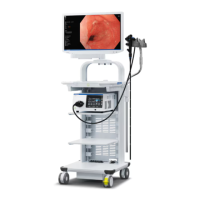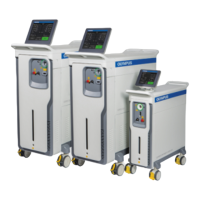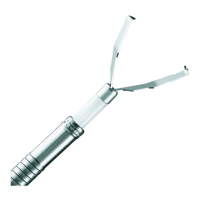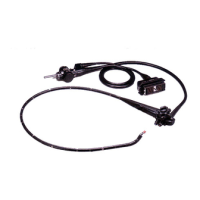8
Important Information — Please Read Before Use
ULTRASOUND GASTROVIDEOSCOPE GF-UCT180
• Never operate the bending section, feed air, perform suction,
insert or withdraw the endoscope’s insertion section, or use
EndoTherapy accessories without viewing the endoscopic
image. Patient injury, bleeding, and/or perforation may result.
• Never operate the bending section, feed air, perform suction,
insert or withdraw the endoscope’s insertion section, or use
EndoTherapy accessories while the image is frozen. Patient
injury, bleeding, and/or perforation may result.
• Never insert or withdraw the insertion section abruptly or with
excessive force. Patient injury, bleeding, and/or perforation
may result.
• Do not touch the light guide of the endoscope connector
immediately after removing it from the light source because it
is extremely hot. Operator or patient burns can result.
• That before each use or after a change of viewing
modes/settings, check to ensure the view observed through
the endoscope provides a live image (rather than a stored
one) and has the correct image orientation. Patient injury,
bleeding, and/or perforation could result.
• When the endoscopic image does not appear on the monitor,
the CCD may have been damaged. Turn the video system
center OFF immediately. Continued power supply in such a
case will cause the distal end to become hot and could cause
operator and/or patient burns.
• Turn ON the diagnostic ultrasound system only when the
ultrasonic cable is connected to both the diagnostic
ultrasound system and the ultrasonic cable connector on the
endoscope. In particular, confirm that the diagnostic
ultrasound system is OFF before connecting or detaching the
ultrasonic cable from the ultrasonic cable connector on the
endoscope. Operator injury may result and/or equipment
damage may result.
• Do not rely on the NBI observation mode alone for primary
detection of lesions or to make a decision regarding any
potential diagnostic or therapeutic intervention.
• Never withdraw the endoscope while the balloon is still
inflated. Otherwise, the balloon may burst or detach from the
distal end of the endoscope. If the balloon cannot be
deflated, insert the single use single-ended cleaning brush
(BW-400L) into the balloon channel. Using slow, short
strokes, carefully feed the brush to remove debris.

